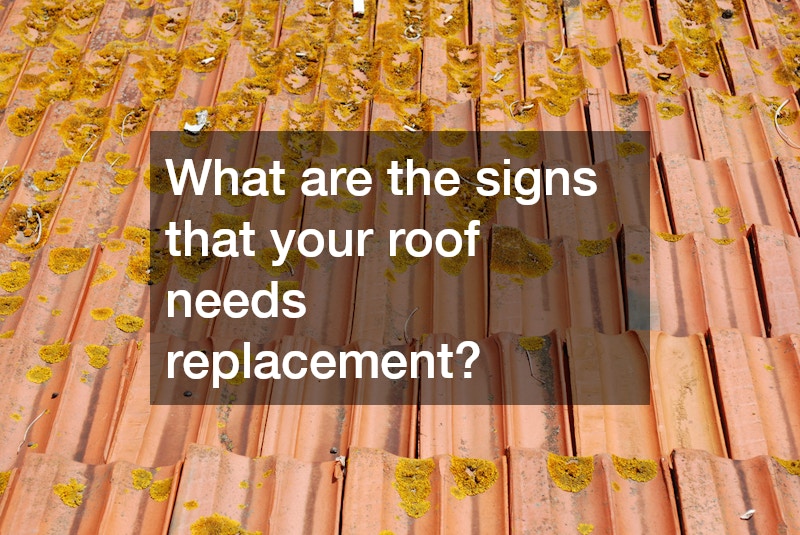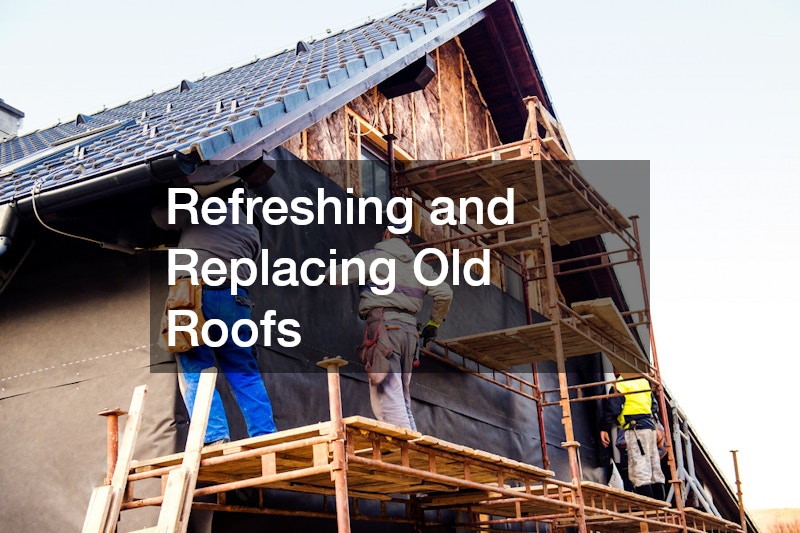Roofs are one of the most vital components of a home. They provide protection from the elements, help maintain indoor temperatures, and contribute significantly to curb appeal and property value. Over time, however, even the most durable roofs deteriorate due to weather exposure, age, and wear. Refreshing or replacing an old roof is a crucial investment that enhances the safety, efficiency, and aesthetics of a home. For many homeowners, this process is a key part of an overall home renovation service that revitalizes both appearance and function. Understanding the signs of roof damage, how to assess roof condition, and the steps and materials involved in replacement can help homeowners make informed decisions that protect their property and budget.
What are the signs that your roof needs replacement?

Visible Damage or Leaks
Visible damage such as missing shingles, cracked tiles, or noticeable leaks inside the home are clear signs that a roof needs attention. Water stains on ceilings or walls, especially after rain, often indicate a compromised roofing system. If you spot signs of water damage, it’s time to consult a local roofer or residential roofing service for an evaluation.
Age of the Roof
Roofs have a finite lifespan. Asphalt shingles typically last 20 to 30 years, while materials like metal, slate, or tile may last longer. If a roof is approaching or has surpassed its expected lifespan, it may be time to consider replacement, even if there are no obvious issues. Roofing companies can help you determine whether it’s more cost-effective to repair or replace.
Increased Energy Bills
Unexplained increases in heating or cooling costs can be attributed to poor roof insulation or air leakage. As roofs age, their ability to regulate indoor temperatures diminishes, leading to increased energy usage and higher bills. A roofing service can assess your insulation and recommend solutions to restore efficiency.
Sagging Roof Areas
A sagging roof deck is a serious sign of structural problems. It could indicate water damage, rotting wood, or compromised supports. Immediate inspection and likely replacement are necessary in such cases, often requiring collaboration with other home renovation service providers.
Shingle Granule Loss
Granules on asphalt shingles protect the roof from UV rays and enhance fire resistance. If gutters are filled with shingle granules, it’s a sign that the roof is deteriorating and losing its protective capabilities. A seamless gutter system can help manage this debris and protect your home’s exterior.
How to assess the condition of old roofs?
Professional Roof Inspections
Hiring a certified roofing contractor for a thorough inspection is the most reliable way to assess a roof’s condition. Roofing companies check for hidden damage, moisture issues, and overall wear that may not be visible to the untrained eye. A local roofer familiar with regional climate challenges is especially valuable.
DIY Roof Inspection Tips
Homeowners can conduct preliminary checks by looking for visible damage from the ground using binoculars or safely accessing the roof. Signs to look for include curling shingles, rusted flashing, and moss or algae growth. Regular maintenance, such as pressure washing by professional pressure washing companies, can help you detect issues early.
Identifying Structural Issues
Check for uneven roof lines or areas where the roof appears to dip. Indoors, look for cracks in the ceiling or walls, which could indicate underlying structural issues related to the roof. Tree service providers can help clear overhanging limbs that exacerbate such problems by dropping debris or causing impact damage.
Evaluating Underlayment
The underlayment is the water-resistant layer between the roofing material and the roof deck. If accessible, inspect this layer for signs of deterioration or moisture damage, especially in older roofs. A roofing service can replace underlayment during full or partial roof renovations.
Checking for Mold or Rot
Mold or rot in the attic or on the roof deck suggests ongoing moisture intrusion. This type of damage not only weakens the roof but can also affect indoor air quality. Mold remediation should be coordinated with a residential roofing service to ensure complete and safe repair.
What are the steps to replace an old roof?

Removing the Old Roof
The first step in a roof replacement is removing the existing materials. This involves stripping off shingles or tiles and disposing of them properly. It allows for a clean surface to assess the decking. Roofers with demolition experience often work with home renovation service teams for efficient removal.
Inspecting the Decking
Once the old roofing is removed, the underlying decking must be inspected. Any rotten, soft, or damaged wood should be replaced to provide a solid foundation for the new roofing materials. This step is essential to ensuring long-term durability.
Choosing the Right Roofing Material
Selecting a roofing material depends on climate, aesthetic preferences, budget, and structural limitations. Asphalt, metal, slate, wood, and green options each have unique advantages and lifespans. Country manor shake is a high-end asphalt alternative that mimics the rich, textured appearance of natural cedar shake, providing elegance and durability.
Installing New Underlayment
The underlayment provides an added layer of protection against moisture. Modern synthetic underlayments are often preferred for their durability and water resistance compared to traditional felt paper.
Securing Shingles or Tiles
After underlayment installation, the final roofing material is applied. This step must be done meticulously to ensure alignment, proper sealing, and resistance to wind and weather. Residential roofing service professionals ensure every layer meets current standards.
What materials are best for replacing old roofs?

Asphalt Shingles
Asphalt shingles are the most common roofing material due to their affordability, ease of installation, and availability in various styles and colors. They offer good performance in most climates and are often used by local roofer teams.
Metal Roofing
Metal roofs are durable, energy-efficient, and recyclable. They resist fire, wind, and pests, and can last 40 to 70 years. Their modern aesthetic also appeals to many homeowners and roofing companies.
Slate Tiles
Slate is a premium roofing option known for its elegance and longevity. A well-maintained slate roof can last over a century, though it requires a strong structure due to its weight.
Wood Shakes
Wood shakes provide a natural, rustic appearance. Cedar is a popular choice due to its resistance to insects and decay. However, wood requires more maintenance and may not be suitable for fire-prone areas.
Green Roofing Options
Green roofs involve living vegetation layers and are growing in popularity for their environmental benefits. They offer insulation, reduce stormwater runoff, and improve air quality, but require special planning and maintenance.
How much does it cost to replace an old roof?
Cost Factors in Roof Replacement
Roof replacement costs depend on material type, roof size, slope, labor, geographic location, and structural repairs needed. Custom features like skylights or chimneys may also increase costs.
Average Cost Estimates
National averages range from $5,000 to $15,000 for asphalt shingles on a standard-sized home. Premium materials like metal or slate can cost significantly more, ranging from $15,000 to $50,000 or higher. High-end options like country manor shake can also add to the final cost.
Budgeting for Hidden Expenses
Unexpected issues such as decking repairs, permit fees, or pest removal can raise the total cost. It’s wise to allocate 10-20% extra in the budget for such contingencies.
Financing Options
Many roofing contractors offer financing plans. Home equity loans, personal loans, and credit cards are common options. Energy-efficient roofs may also qualify for rebates or tax credits.
Cost-Benefit Analysis
Although costly upfront, roof replacement can yield long-term savings through improved energy efficiency, reduced maintenance, and increased home value. Quality roofing materials also extend lifespan and performance.
How can you extend the life of an old roof?
Regular Maintenance Tips
Routine inspections and minor repairs help extend roof life. Look for damaged shingles, exposed nails, and deteriorated flashing, addressing issues promptly before they escalate.
Importance of Gutter Cleaning
Clogged gutters can cause water to back up under the roof, leading to rot and leaks. Cleaning gutters regularly prevents water damage and maintains proper drainage. A seamless gutter installation by roofing service providers improves longevity and reduces maintenance needs.
Roof Coatings
Reflective or waterproof coatings can be applied to some roofing materials to extend their lifespan, improve energy efficiency, and reduce heat absorption.
Proper Ventilation
Good attic ventilation prevents moisture buildup and reduces heat accumulation, which can damage roofing materials over time. Soffit vents, ridge vents, and attic fans all contribute to healthy airflow.
Timely Repairs
Addressing minor problems as they arise prevents them from developing into costly issues. Replacing a few shingles or sealing a small leak early can save thousands down the line.
What are the environmental considerations when replacing old roofs?
Recycling Old Roofing Materials
Many old roofing materials, especially asphalt shingles and metal, can be recycled. Recycling reduces landfill waste and the demand for raw materials.
Energy-Efficient Roofing Materials
Materials with high solar reflectance and thermal emittance reduce energy consumption by keeping homes cooler. Cool roofs, metal roofs, and reflective coatings are environmentally beneficial options.
Impact of Roofing Waste
Roof replacements generate significant waste. Choosing recyclable materials, minimizing packaging, and working with eco-conscious contractors can reduce environmental impact.
Sustainable Roofing Practices
Sustainability includes using locally sourced materials, reducing installation waste, and choosing roofs with long lifespans. Green certifications may also indicate environmentally responsible products.
Using Solar Roof Panels
Incorporating solar panels during roof replacement is an effective way to enhance energy efficiency. Solar roofing integrates energy production with weather protection, reducing reliance on fossil fuels.
Can you DIY a roof replacement?
Pros and Cons of DIY Roofing
DIY roofing can save money on labor, but it requires skill, tools, and physical ability. Mistakes can lead to leaks, structural issues, or voided warranties. Weighing the risks is essential.
Essential Tools and Materials
Key tools include ladders, roofing nailers, pry bars, chalk lines, and safety harnesses. Materials vary by roof type but generally include shingles, underlayment, nails, flashing, and sealant.
Safety Considerations
Roofing is hazardous work. Proper safety gear, stable ladders, and fall protection systems are vital. Weather conditions and roof pitch also affect safety. Consider hiring professionals from roofing companies or pressure washing companies if your roof is slippery or heavily soiled.
Step-by-Step DIY Guide
The process includes removing old roofing, inspecting and repairing decking, installing underlayment, and applying new shingles or tiles. Each step must follow manufacturer guidelines and local codes.
When to Call a Professional
If the roof is steep, complex, or structurally compromised, it’s best to hire a professional. Licensed contractors bring experience, safety training, and warranties that protect homeowners.
What permits are needed for replacing old roofs?
Understanding Local Building Codes
Roof replacements usually require compliance with local building codes that govern materials, installation methods, and structural support. These vary by jurisdiction.
How to Apply for Permits
Homeowners or contractors can apply for permits through the local building department. The application typically includes project details, materials used, and estimated costs.
Importance of Inspections
Inspections ensure the roof meets code and safety standards. They may occur before, during, and after the replacement process, depending on local regulations.
Permit Fees and Costs
Fees vary widely but are generally based on project size and value. Some areas charge a flat rate, while others calculate fees as a percentage of the total cost.
Legal Consequences of Skipping Permits
Skipping permits can result in fines, required removal of unapproved work, and complications during home resale. Permits protect homeowners and ensure legal compliance.
How to choose a roofing contractor for an old roof replacement?

Checking Credentials and Experience
Verify that the contractor is licensed, bonded, and insured. Experience with the specific roofing material being used is also critical for proper installation.
Reading Contractor Reviews
Online reviews and testimonials provide insight into a contractor’s reliability and customer satisfaction. Look for patterns in feedback, both positive and negative.
Comparing Quotes
Obtain multiple quotes to compare pricing, scope of work, and warranties. Be cautious of unusually low bids, which may signal inferior materials or workmanship.
Evaluating Past Work
Ask to see examples of previous roofing jobs. Photos, references, and site visits to completed projects help gauge quality and style compatibility.
Establishing a Contract
A detailed contract should outline the project timeline, materials, labor costs, warranty terms, and payment schedule. Clear communication helps prevent misunderstandings.
Final Thoughts
Replacing or refreshing an old roof is a significant but worthwhile investment that safeguards a home’s integrity, efficiency, and appearance. Recognizing signs of wear, understanding the replacement process, choosing the right materials and contractors, and planning for costs and environmental impacts ensure a successful project. Whether taking the DIY route or hiring a professional, timely roof replacement provides peace of mind and long-term value for homeowners. Integrating services like seamless gutter installation, pressure washing companies, and tree service providers can further enhance the effectiveness and longevity of your new roof and complete your home renovation service with confidence.
